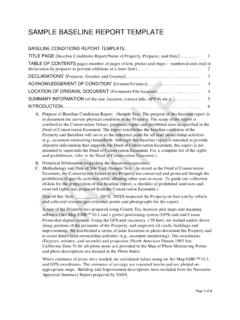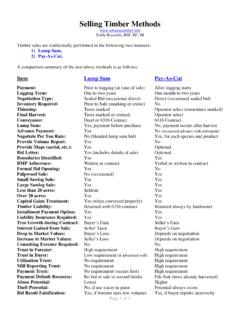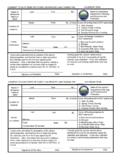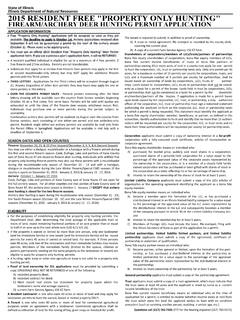Transcription of 'Interim Guidance Regarding Criteria Landowners …
1 II. Background The bona fide prospective purchaser provision, CERCLA 107(r), provides a new landowner liability protection and limits EPA s recourse for unrecovered response costs to a lien on property for the increase in fair market value attributable to EPA s response action. To qualify as a bona fide prospective purchaser, a person must meet the Criteria set forth in CERCLA 101(40), many of which are discussed in this memorandum. A purchaser of property must buy the property after January 11, 2002 (the date of enactment of the Brownfields Amendments), in order to qualify as a bona fide prospective purchaser. These parties may purchase property with knowledge of contamination after performing all appropriate inquiry, and still qualify for the landowner liability protection, provided they meet the other Criteria set forth in CERCLA 101(40).
2 2 The new contiguous property owner provision, CERCLA 107(q), excludes from the definition of owner or operator a person who owns property that is contiguous or otherwise similarly situated to, a facility that is the only source of contamination found on his property. To qualify as a contiguous property owner, a landowner must meet the Criteria set forth in CERCLA 107(q)(1)(A), many of which are common elements. This landowner provision protects parties that are essentially victims of pollution incidents caused by their neighbor s actions. S. Rep. No. 107-2, at 10 (2001). Contiguous property owners must perform all appropriate inquiry prior to purchasing property. Persons who know, or have reason to know, prior to purchase, that the property is or could be contaminated, cannot qualify for the contiguous property owner liability The Brownfields Amendments also clarified the CERCLA 107(b)(3) innocent landowner affirmative defense.
3 To qualify as an innocent landowner, a person must meet the Criteria set forth in section 107(b)(3) and section 101(35). Many of the Criteria in section 101(35) are common elements. CERCLA 101(35)(A) distinguishes between three types of innocent Landowners . Section 101(35)(A)(i) recognizes purchasers who acquire property without knowledge of the contamination. Section 101(35)(A)(ii) discusses governments acquiring contaminated property by escheat, other involuntary transfers or acquisitions, or the exercise of eminent domain authority by purchase or condemnation. Section 101(35)(A)(iii) covers inheritors of contaminated property. For purposes of this Guidance , the term innocent landowner refers only to the unknowing purchasers as defined in section 101(35)(A)(i). Like 2 For a discussion of when EPA will consider providing a prospective purchaser with a covenant not to sue in light of the Brownfields Amendments, see Bona Fide Prospective Purchasers and the New Amendments to CERCLA, B.
4 Breen (May 31, 2001). 3 CERCLA 107(q)(1)(C) provides that a person who does not qualify as a contiguous property owner because he had, or had reason to have, knowledge that the property was or could be contaminated when he bought the property, may still qualify for a landowner liability protection as a bona fide prospective purchaser, as long as he meets the Criteria set forth in CERCLA 101(40). 3 contiguous property owners, persons desiring to qualify as innocent Landowners must perform all appropriate inquiry prior to purchase and cannot know, or have reason to know, of contamination in order to have a viable defense as an innocent landowner. III. Discussion A party claiming to be a bona fide prospective purchaser, contiguous property owner, or section 101(35)(A)(i) innocent landowner bears the burden of proving that it meets the conditions of the applicable landowner liability Ultimately, courts will determine whether Landowners in specific cases have met the conditions of the landowner liability protections and may provide interpretations of the statutory conditions.
5 EPA offers some general Guidance below Regarding the common elements. This Guidance is intended to be used by Agency personnel in exercising enforcement discretion. Evaluating whether a party meets these conditions will require careful, fact-specific analysis. A. Threshold Criteria To qualify as a bona fide prospective purchaser, contiguous property owner, or innocent landowner, a person must perform all appropriate inquiry before acquiring the property. Bona fide prospective purchasers and contiguous property owners must, in addition, demonstrate that they are not potentially liable or affiliated with any other person that is potentially liable for response costs at the property. 1. All Appropriate Inquiry To meet the statutory Criteria of a bona fide prospective purchaser, contiguous property owner, or innocent landowner, a person must perform all appropriate inquiry into the previous ownership and uses of property before acquisition of the property.
6 CERCLA 101(40)(B), 107(q)(1)(A)(viii), 101(35)(A)(i),(B)(i). Purchasers of property wishing to avail themselves of a landowner liability protection cannot perform all appropriate inquiry after purchasing contaminated property. As discussed above, bona fide prospective purchasers may acquire property with knowledge of contamination, after performing all appropriate inquiry, and maintain their protection from liability. In contrast, knowledge, or reason to know, of contamination prior to purchase defeats the contiguous property owner liability protection and the innocent landowner liability protection. The Brownfields Amendments specify the all appropriate inquiry standard to be applied. The Brownfields Amendments state that purchasers of property before May 31, 1997 shall take into account such things as commonly known information about the property, the value of the property if clean, the ability of the defendant to detect contamination, and other similar Criteria .
7 CERCLA 101(35)(B)(iv)(I). For property purchased on or after May 31, 1997, the procedures 4 CERCLA 101(40), 107(q)(1)(B), 101(35). 4 of the American Society for Testing and Materials ( ASTM ), including the document known as Standard E1527 - 97, entitled Standard Practice for Environmental Site Assessments: Phase 1 Environmental Site Assessment Process, are to be used. CERCLA 101(35)(B)(iv)(II). The Brownfields Amendments require EPA, not later than January 2004, to promulgate a regulation containing standards and practices for all appropriate inquiry and set out Criteria that must be addressed in EPA s regulation. CERCLA 101(35)(B)(ii), (iii). The all appropriate inquiry standard will thus be the subject of future EPA regulation and Guidance . 2. Affiliation To meet the statutory Criteria of a bona fide prospective purchaser or contiguous property owner, a party must not be potentially liable or affiliated with any other person who is potentially liable for response Neither the bona fide prospective purchaser/contiguous property owner provisions nor the legislative history define the phrase affiliated with, but on its face the phrase has a broad definition, covering direct and indirect familial relationships, as well as many contractual, corporate, and financial relationships.
8 It appears that Congress intended the affiliation language to prevent a potentially responsible party from contracting away its CERCLA liability through a transaction to a family member or related corporate entity. EPA recognizes that the potential breadth of the term affiliation could be taken to an extreme, and in exercising its enforcement discretion, EPA intends to be guided by Congress intent of preventing transactions structured to avoid liability. The innocent landowner provision does not contain this affiliation language. In order 5 The bona fide prospective purchaser provision provides, in pertinent part: NO AFFILIATION The person is not (i) potentially liable, or affiliated with any other person that is potentially liable, for response costs at a facility through (I) any direct or indirect familial relationship; or (II) any contractual, corporate, or financial relationship (other than a contractual, corporate, or financial relationship that is created by the instruments by which title to the facility is conveyed or financed or by a contract for the sale of goods or services); or (ii) the result of a reorganization of a business entity that was potentially liable.
9 CERCLA 101(40)(H). The contiguous property owner provision provides, in pertinent part: NOT CONSIDERED TO BE AN OWNER OR OPERATOR .. (ii) the person is not (I) potentially liable, or affiliated with any other person that is potentially liable, for response costs at a facility through any direct or indirect familial relationship or any contractual, corporate, or financial relationship (other than a contractual, corporate, or financial relationship that is created by a contract for the sale of goods or services); or (II) the result of a reorganization of a business entity that was potentially liable[.] CERCLA 107(q)(1)(A)(ii). 5 to meet the statutory Criteria of the innocent landowner liability protection, however, a person must establish by a preponderance of the evidence that the act or omission that caused the release or threat of release of hazardous substances and the resulting damages were caused by a third party with whom the person does not have an employment, agency, or contractual relationship.
10 Contractual relationship is defined in section 101(35)(A). B. Continuing Obligations Several of the conditions a landowner must meet in order to achieve and maintain a landowner liability protection are continuing obligations. This section discusses those continuing obligations: (1) complying with land use restrictions and institutional controls; (2) taking reasonable steps with respect to hazardous substance releases; (3) providing full cooperation, assistance, and access to persons that are authorized to conduct response actions or natural resource restoration; (4) complying with information requests and administrative subpoenas; and (5) providing legally required notices. 1. Land Use Restrictions and Institutional Controls The bona fide prospective purchaser, contiguous property owner, and innocent landowner provisions all require compliance with the following ongoing obligations as a condition for maintaining a landowner liability protection: the person is in compliance with any land use restrictions established or relied on in connection with the response action and the person does not impede the effectiveness or integrity of any institutional control employed in connection with a response action.















